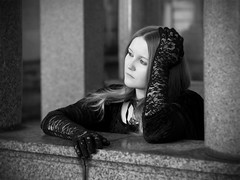 Had another shoot with the lovely Sorcha-Laoise (aka Sazza), this time in Glasgow. It was a bit of a marathon: she travelled down from Elgin on Wednesday morning, returned on Thursday afternoon, and in between times we tried to cram as many opportunities as possible.
Had another shoot with the lovely Sorcha-Laoise (aka Sazza), this time in Glasgow. It was a bit of a marathon: she travelled down from Elgin on Wednesday morning, returned on Thursday afternoon, and in between times we tried to cram as many opportunities as possible.Wednesday afternoon started with a quick trip to the Campsies for some waterfall nudes, although the tricky light and Baltic water meant it was nowhere near as productive as our last shoot at Fairy Glen. Back into Glasgow as the light fell for some outfit shopping, and then some indoor stuff at her hotel room.
Thursday... yeesh. Thursday should have been a day of opportunity, but thanks to the pettiness of overzealous local council employees, I came away with a bitter taste in my mouth. At the Glasgow Necropolis, two gardeners arrived on a motorised cart and told us we needed permission to shoot from the Parks & Recreations Department because, among other things, "the gravestones are protected by copyright". In a Victorian cemetery. I talked our way out of that by stating that neither model nor photographer was being paid, so it wasn't a commercial shoot, and I think they probably had too much work to be bothered chasing us.
Worse was to come, though. At the Kelvingrove Art Gallery we were chased off the steps by one of those eager little Hitlers, even though the shots were using Glasgow University as the background. There was no check to see if we had permission, no questions to ascertain if it was a commercial shoot. No, apparently SLRs just aren't allowed any more. A hundred to one we'd have been left in peace if I had a point'n'shoot or a cameraphone. Just to spite him, we went round to the front and took shots with the Art Gallery itself as the backdrop, but my mind wasn't in it any more and the pictures turned out a bit rubbish.
I know there's a lot of 'togs bitch about their commercial rights being violated by modern technologies. However, I don't see why laws can't be drafted which protect those creative individuals today, while allowing others to take advantage of buildings and public spaces which are over a hundred years old. And anyway, why do buildings have "commercial image rights" which seem to last in perpetuity, or at least as long as the building is standing? A work of art is created and copyright is established, but it eventually expires (70 years + creator's lifetime, or whatever). So why do the same rules not apply to buildings and structures, especially since they're in public spaces?
Money talks. That's the answer to the rhetorical questions above, of course. I suspect, though, that in their eagerness to protect their own interests, photographers who support the Draconian copyright laws which currently exist may in fact be eroding their future freedoms.
No comments:
Post a Comment